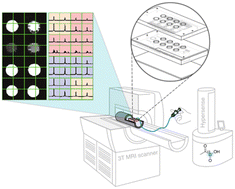Parallel detection of chemical reactions in a microfluidic platform using hyperpolarized nuclear magnetic resonance†
Abstract
The sensitivity of NMR may be enhanced by more than four orders of magnitude via dissolution dynamic nuclear polarization (dDNP), potentially allowing real-time, in situ analysis of chemical reactions. However, there has been no widespread use of the technique for this application and the major limitation has been the low experimental throughput caused by the time-consuming polarization build-up process at cryogenic temperatures and fast decay of the hyper-intense signal post dissolution. To overcome this limitation, we have developed a microfluidic device compatible with dDNP-MR spectroscopic imaging methods for detection of reactants and products in chemical reactions in which up to 8 reactions can be measured simultaneously using a single dDNP sample. Multiple MR spectroscopic data sets can be generated under the same exact conditions of hyperpolarized solute polarization, concentration, pH, and temperature. A proof-of-concept for the technology is demonstrated by identifying the reactants in the decarboxylation of pyruvate via hydrogen peroxide (e.g. 2-hydroperoxy-2-hydroxypropanoate, peroxymonocarbonate and CO2). dDNP-MR allows tracing of fast chemical reactions that would be barely detectable at thermal equilibrium by MR. We envisage that dDNP-MR spectroscopic imaging combined with microfluidics will provide a new high-throughput method for dDNP enhanced MR analysis of multiple components in chemical reactions and for non-destructive in situ metabolic analysis of hyperpolarized substrates in biological samples for laboratory and preclinical research.



 Please wait while we load your content...
Please wait while we load your content...